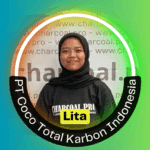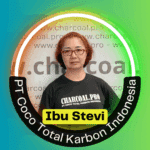Choosing a reliable coconut charcoal briquette manufacturer with the highest quality, consistency, and production capacity
My name is Greg Ryabtsev – an expert in coconut shell charcoal manufacturing with 10+ years of experience in the industry.
In this article, I will explore key factors that wholesale buyers should consider while choosing shisha charcoal manufacturer: quality, consistency, production capacity and compliance.
When I started writing this article, I thought I could finish it in one day, but after going deep into the topic, I spent almost two weeks 65+ hours of writing and correcting. I would greatly appreciate your feedback and comments on this article.
As the wholesale bulk buyer (or importer/distributor) of hookah coals, you surely understand the importance of choosing a reliable coconut charcoal briquette manufacturer.
You need a consistent (in each container, the same quality) and adequately priced factory that makes you the best quality.
Otherwise, how are you going to sell and beat the competitors like Cocoloco, BlackCoco’s, Coco Urth, Titanium, One Nation, 320, 27er, and others.
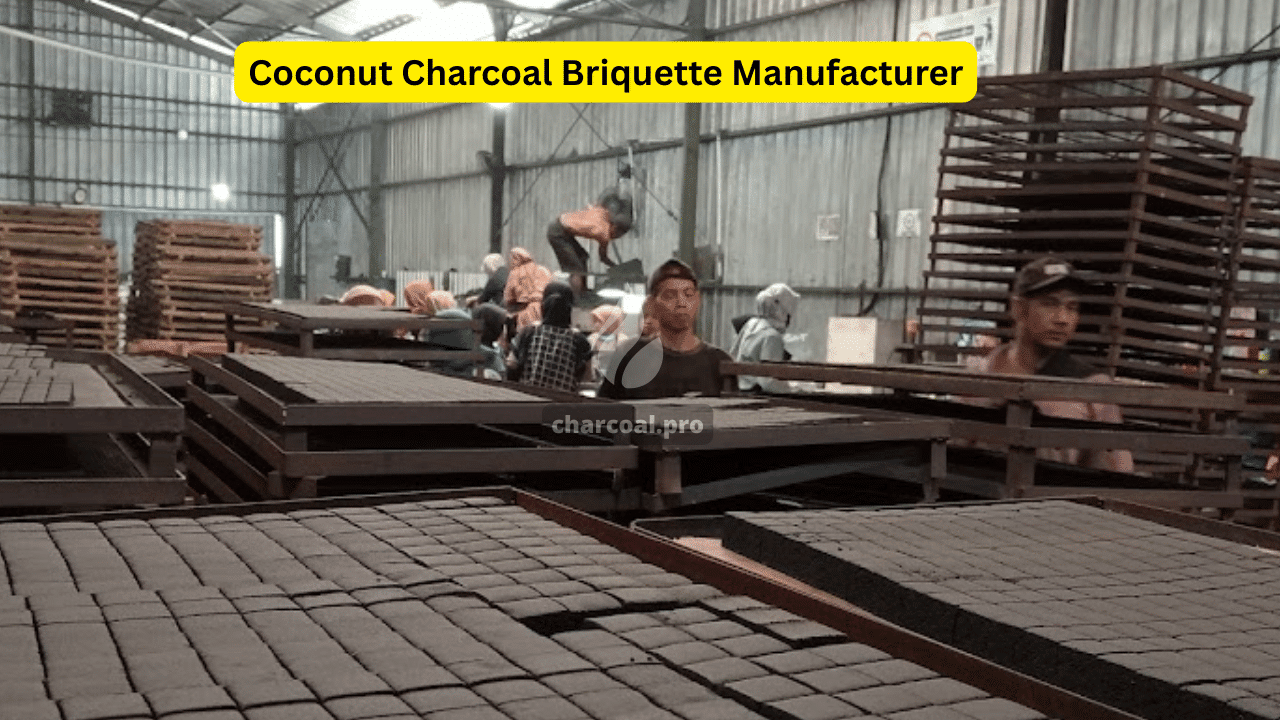
Main discussion topic
In my opinion and my experience, shisha charcoal buyers should consider four main topics:
- quality of the shisha charcoal,
- consistency in every batch,
- production capacity (ie, how fast it can be delivered to you)
- Compliance with standards and certifications
What are the Coconut Charcoal Briquettes
In this article, we will discuss and focus only on shisha (hookah) charcoal, so we omit BBQ, heating, and other types.
Coconut charcoal briquettes are briquettes made from compressed coconut shell charcoal (95-99%), tapioca (as the binder 1-5%), and spring water.

The shape of hookah charcoal briquettes is usually square (with sizes of 20, 22, 25, 26, 27, and 28 mm), hexagonal, tube (also called stix or finger), octagonal, dome-shaped, or kalaud (mercy leaf) shaped. The shape is made during the extrusion and cutting processes.
Why is Coconut shell charcoal considered the best raw material for hookah charcoal?
Simply because of its characteristics. First of all, the high heat output – it burns at a temperature of 650-750 °C. But not only heat, but also clean output. Meaning that when you smoke shisha, the charcoal does not influence the taste. Basically, it has no taste or smell at all.
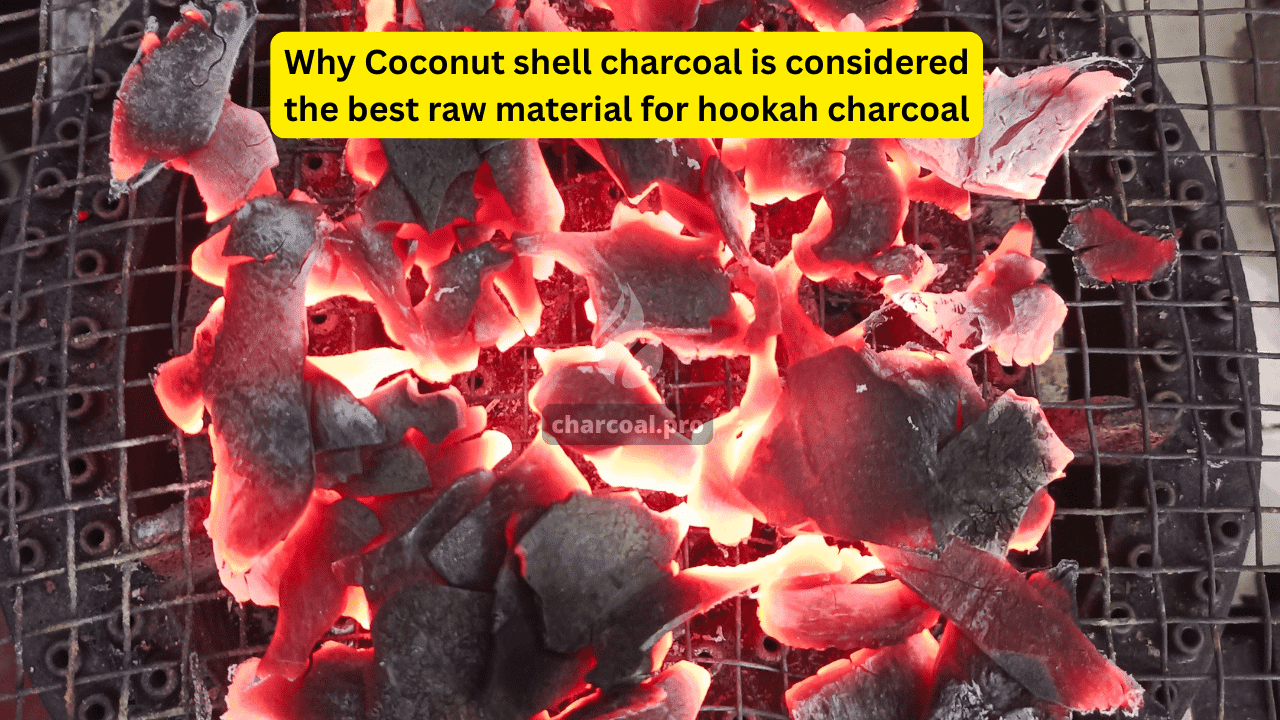
The other important thing is that coconut charcoal generates very low ash (about 1.6-1.9%) and very clean, white (silverish) color ash. So it not only gives you great temperature for a long time (about 1-2 hours) but also it looks very nice with falling down ash.
Another point is that coconut shell charcoal is not wood – it is agricultural waste, so we do not cut trees but we protect our forests using the sub-product of coconuts.
Why Wholesale Buyers Need a Trusted Manufacturer
Simply because your real intent as the wholesale buyer is to make a profit (money) by reselling shisha charcoal. To do it, you need a) good quality and b) consistency.
If you buy shisha charcoal from the manufacturer just based on price (cheaper price – buying), without considering if it is trusted and reliable, you have a high risk of inconsistent quality.
For example, a 40 ft container can fit 25 tons of cube 25 mm shisha charcoal. This means there are 1800000 pieces of cubes in this container (it is one million eight hundred!). So the challenge is to make sure all of them are the same quality.
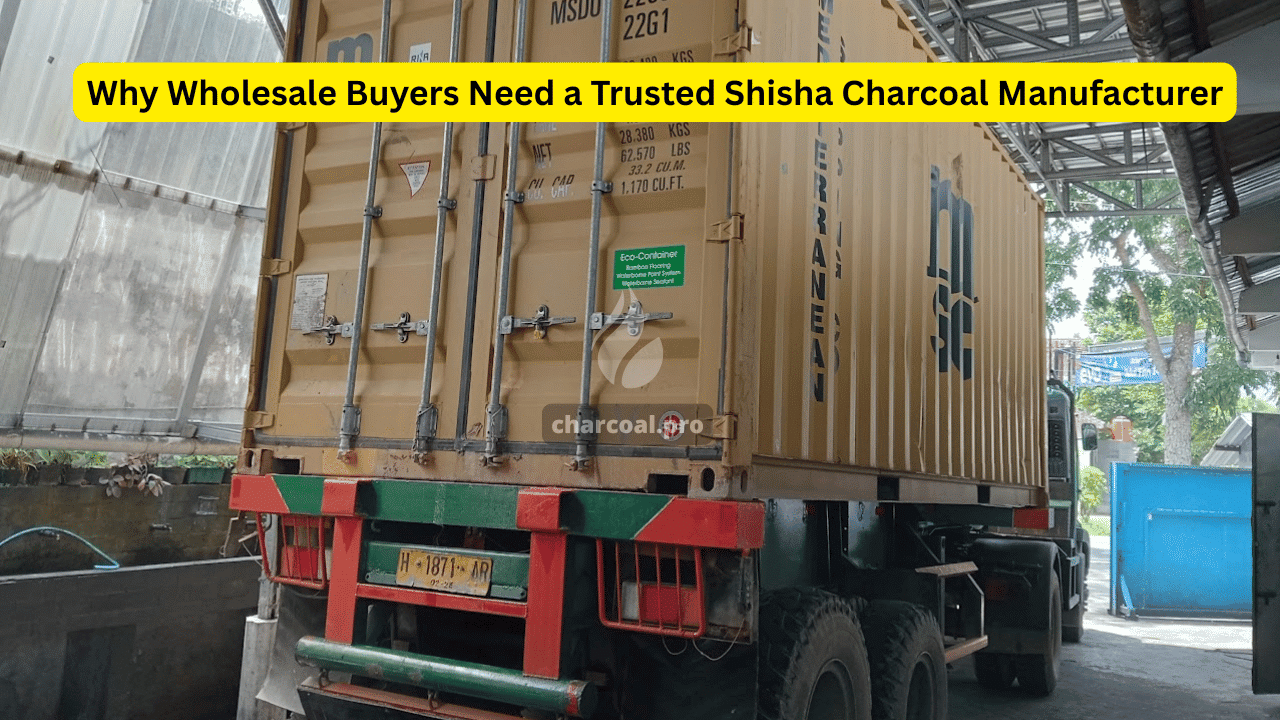
It is more than the 6 sigma quality requirements. Otherwise, how can you compete with other brands on the market?
And do not forget about shipping shisha charcoal – it is a tricky operation. Not all shipping lines accept shisha charcoal for delivery. Only a few shipping lines do it, but they require additional certification and documentation for the shipping.
How We Manufacture High-Quality Coconut Charcoal Briquettes
My experience of 10+ years in the industry shows me that only manufacturers focused on quality can constantly supply good quality. So, what is the difference between just a manufacturer and a reliable, consistent, and trusted charcoal briquette manufacturer?

How a high-quality coconut charcoal briquette manufacturer ensures consistency
We use 7-step quality control process with an in-house quality team that ensures the stability and consistency of the charcoal from raw material to final packaging.
Table 1: Coconut Charcoal Briquette Manufacturing Process Steps
| Step | Stage Name | Key Actions & Parameters | Quality Focus |
|---|---|---|---|
| 1 | Raw Material Prep & Carbonization | Select aged shells; Carbonize at 500-800°C | Maximize fixed carbon, remove volatile matter, use quality raw materials |
| 2 | Crushing & Sieving | Crush charcoal; Grind to fine powder; Sieve for uniform particle size | Maximize fixed carbon, remove volatile matter, and use quality raw materials |
| 3 | Mixing | Blend charcoal powder, tapioca binder, water in precise ratios | Blend charcoal powder, tapioca binder, and water in precise ratios |
| 4 | Molding / Briquetting | Blend charcoal powder, tapioca binder, and water in precise ratios | Ensure consistent shape, size, and density; prevent molding defects |
| 5 | Drying | Dry briquettes in oven (e.g., 80-160°C for 24-72 hrs) | Reduce moisture content (<6%); Ensure hardness and stability; prevent cracking |
| 6 | Packaging | Compress the mixture into desired shapes (e.g., cubes, hexagonal) using high pressure | Protect from moisture absorption; ensure safe transport and shelf life Export to Sheets |
| 7 | Quality Control | Visual checks, drop test, lab analysis (ash, moisture, carbon etc.) | Verify compliance with specifications; ensure hardness and integrity |
| 8 | Shipping/Delivery | Shipping to the customer | Dry and safe delivery of shisha charcoal |
Raw material selection and Carbonization
It all starts with raw material – coconut shell charcoal. How it was carbonized, i.e., burned with oxygen. We operate two burning plants, one in Halmahera and another in Temanggung.
First of all, you need naturally old coconut shells. Not the green one, but already exposed to the open sunlight for at least one month, with hard shells.
If you use young coconuts, be ready to have a very small output after carbonization and a low level of carbon.
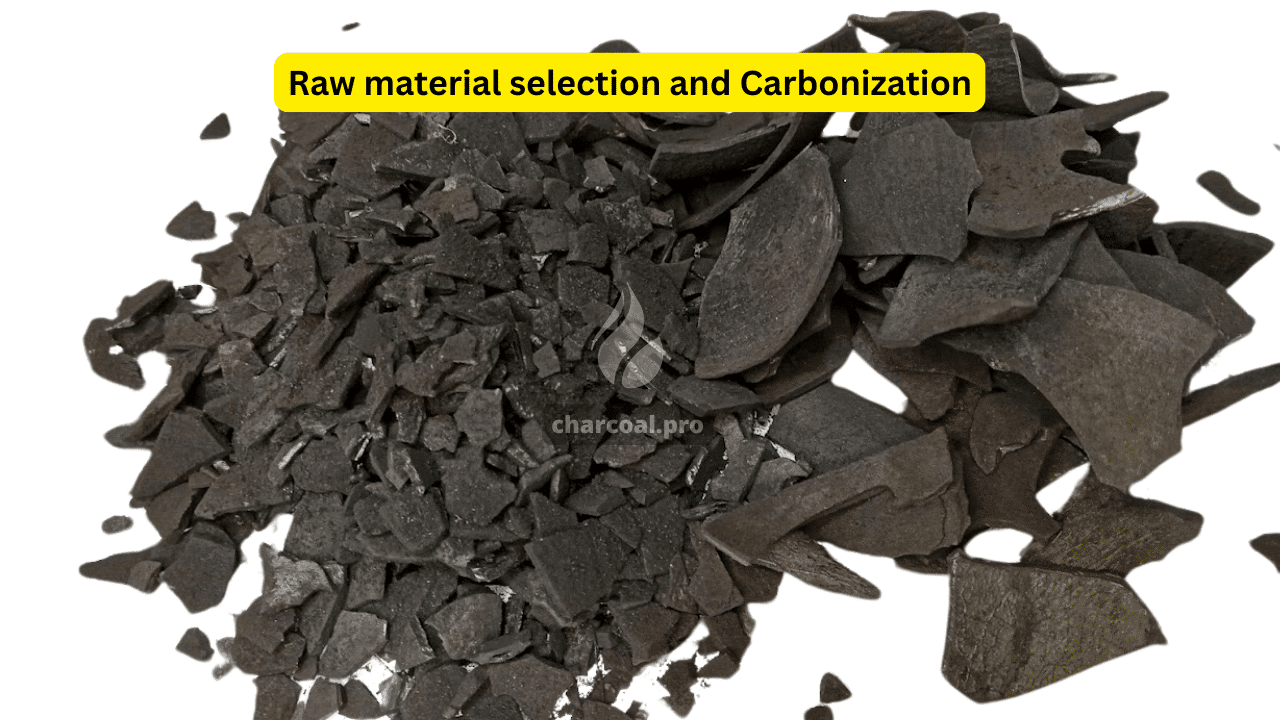
Only old coconut shells, properly cleaned from their “hair” and dirt, can be used for the production.
The area where coconut shells were growing is also significantly influenced by the ash color and ash content. The best areas for coconut shell charcoal used in hookah smoking are North Sulawesi, Halmahera, and Maluku. Some parts of Java Island and some parts of Sumatra.
One more important component of the coconut charcoal briquettes is tapioca. We have to use only certain types of tapioca to ensure it is the binder while having no smell.
Grinding and Mixing Processes
After we finish the process of the pyrolysis of coconut shells, we have to grind them into small particles. Our factory is using 3×450 horsepower industrial grinders to make up to 15 tons of ground powder of charcoal.
It looks like an easy process, but the trick is how to mix coconut shells from different areas to get consistent similar ash color and ash content.
This is what I personally call the art of the shisha charcoal. Different areas (Sulawesi, Sumatra, Java) produce different colors of ash charcoal. So the correct mixture makes us sure we can supply you with high-quality hookah coals and, most importantly, consistent quality
Briquette Extrusion and Shaping
After mixing and grinding, we move the charcoal to the briquette extrusion and cutting machines. Here, we add shape to the briquettes. Cubes, hexagons, tubes, Stix, and many other shapes are made during this stage.
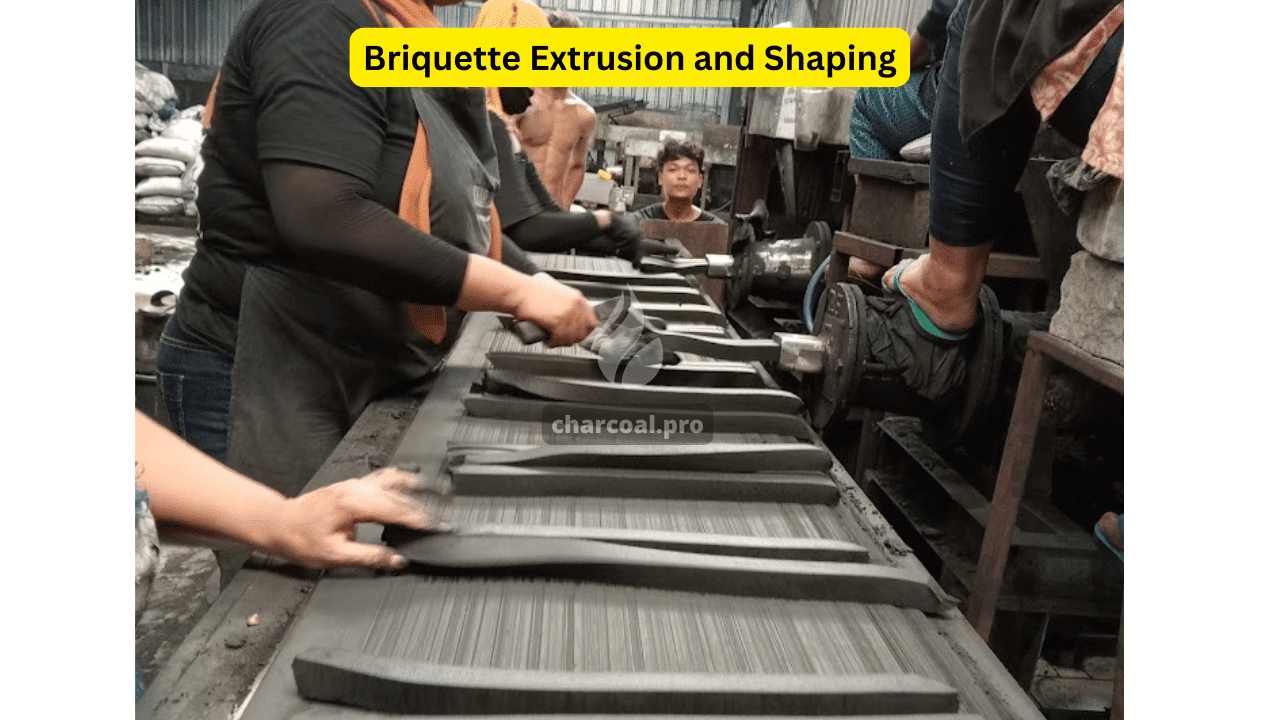
It is very important to keep good quality control to make sure that the shape is nice and sharp.
But not only is the shape made during this stage. The level of “test drop,” i.e., how strong is the briquette is or how many falls to the floor it can stand, is determined on this stage too.
Drying and Packaging
After we make the shape of the briquette, we process it to the drying (ovening) process. Our shisha charcoal factory operates 7 ovens (3 gas and 4 wood-powered), with a capacity from 1.5 tons to 7 tons. Depending on the quality and quantity of the manufactured charcoal.
Drying takes about 72 to 96 hours with temperatures up to 150-175 °C. This process ensures that all moisture in the briquette is evaporated, and our shisha charcoal is ready at 3-4% moisture (best for burning).
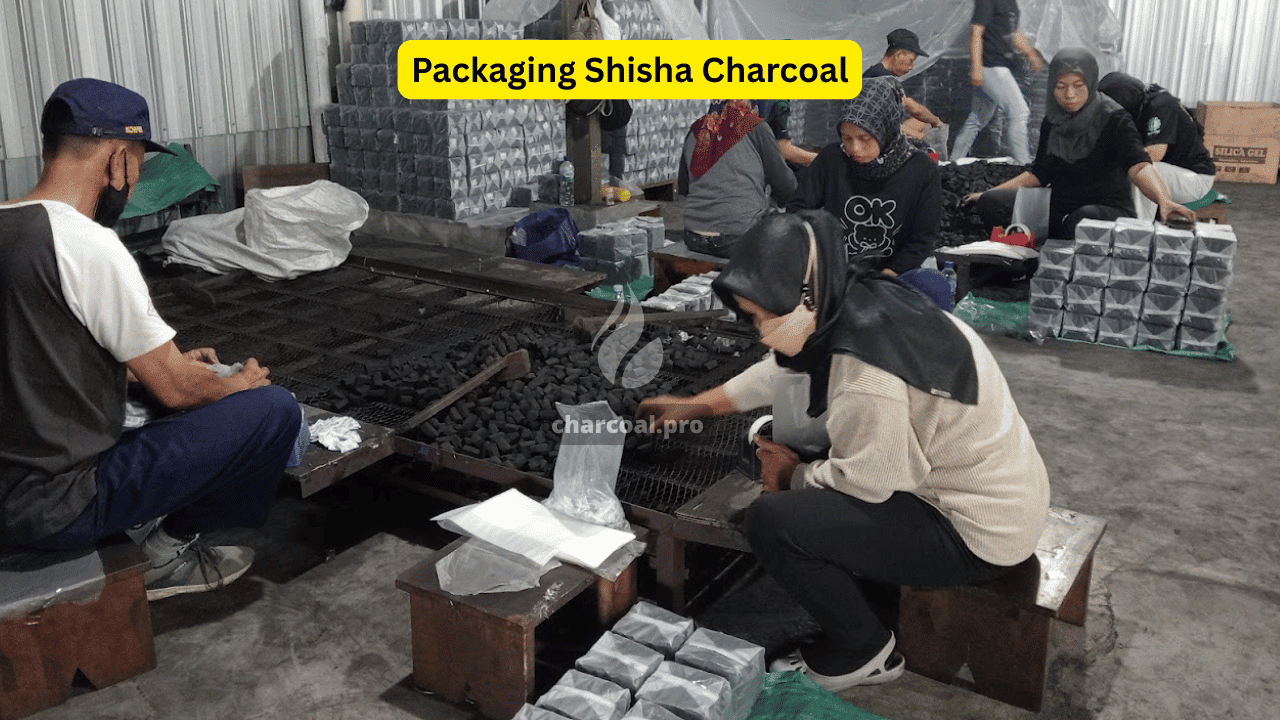
After the drying process, briquettes are finally checked by the Quality Control team and packed to the client’s boxes. For sure, before packing, there is a process called weathering, where we have to give a certain time for the shisha charcoal to rest and cool down.
Quality control and laboratory testing
Actually, the quality control team takes samples at each step. There are 7 steps in the quality control procedure. So we take tests from raw material to the final (packaged) product. We also send our samples to an independent laboratory for the cross-checking of our results.
Key quality parameters in coconut charcoal briquettes
What makes the best quality the best coconut charcoal briquettes? Simply, it is smooth and nice smoking of hookah. Feeling all the taste of the tobacco without “charcoal” smell and free from headache. But not just smoking, but smoking during a certain amount of time, in most cases from 45 minutes to 1.5 hours.
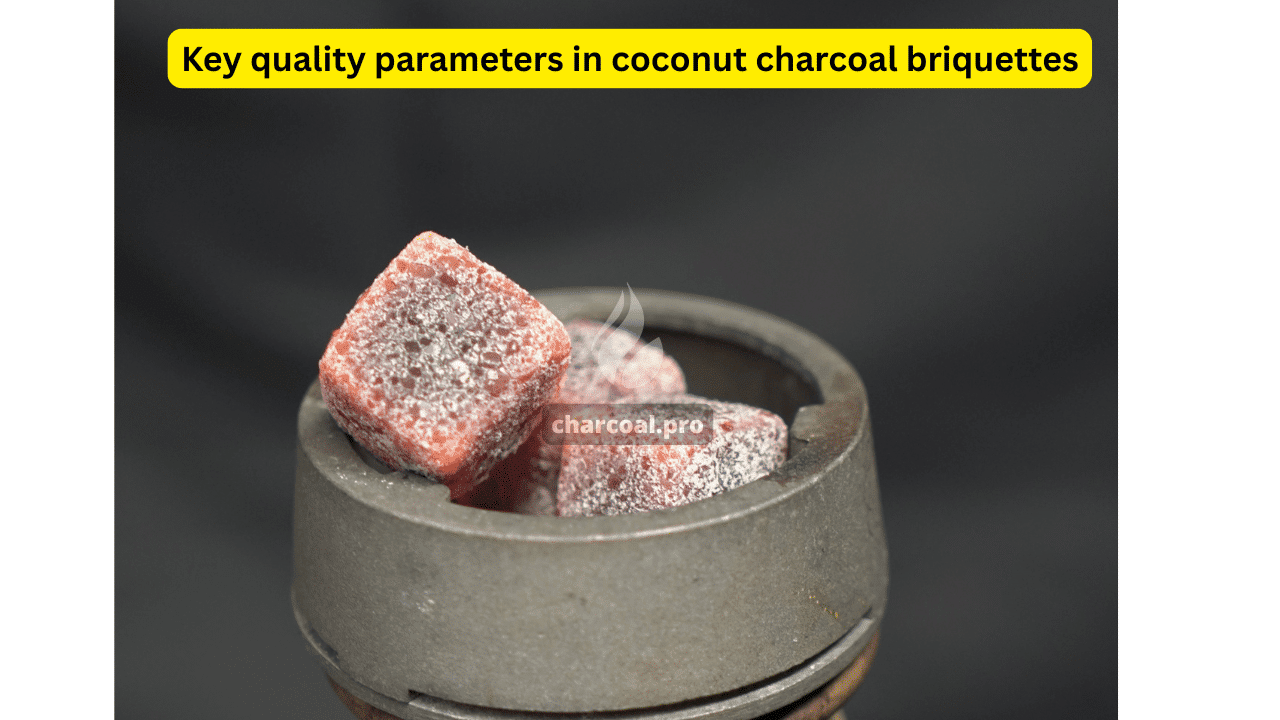
Table 2: Key Quality Parameters for Premium Coconut Charcoal Briquettes
| Parameter | Ideal Target / Description | Significance | Influenced By |
|---|---|---|---|
| Ash Content | < 1.4% – 2.0% | Purity, clean burn, less residue, affects flavor | Raw material quality, carbonization process, binder type/amount |
| Ash Color | White / Light Grey | Indicates complete combustion, minimal impurities | Raw material source, combustion efficiency |
| Moisture Content | < 6% | For shisha smokers, opening the taste of the tobacco | Drying process (temp/duration), storage conditions |
| Fixed Carbon | 80% – 85% | Heat output, burning duration | Carbonization process (temp/duration), raw material quality |
| Volatile Matter | < 13% – 15% | Important for the smell and odor | Reduces smoke, odor, and sparks |
| Burning Time | 2 hours | Longevity, user convenience | Fixed carbon, density, shape/size, binder |
| Smell / Smoke | Odorless, Smokeless (during steady burn) | User experience, indoor use suitability (shisha) | Volatile matter content, purity of materials |
| Cracks / Hardness | Durability, handling, and prevents crumbling | Ignition ease, burning efficiency, stability, and prevents sparks/steam | Mixing ratio, compression pressure, drying process, binder quality/quantity Export to Sheets |
| Output heat | 650 °C No cracks, passes the drop test | For shisha smokers, opening the taste fo the tobacco | 650 °C outside and 220 °C inside the bowl |
No smell, no smoke, no cracks
These are the basic things that all charcoal has to possess. This means that while you smoke shisha, you do not taste or smell the charcoal. Your briquettes do not break apart and keep strong during the smoking period (usually about 1-1.5 hours).
For sure, you should not have any smoke coming from briquettes, too.
Low ash
Less ash is better. Why? Less ash means more heat output and less possibility that the ash will fall down on the foil or go to the shisha bowl. If the ash is too much and it falls into the shisha bowl, it can change the taste of the tobacco.
The color of ash is very important for the visual. While you smoke, you relax and watch the flame of the charcoal. It should be smooth, bright, and nice. If the ash is dark or the flame is low, you cannot enjoy shisha.
High heat output and stable burning time
Yes, we smoke shisha usually for 45-90 minutes, meaning we have to make sure our charcoal briquettes keep the temperature and heat output for this amount of time.
So, on one hand, it should not overheat the tobacco, and on the other hand, it should give enough heat output to keep the tobacco slowly burning and evaporating the taste.
Low moisture, High Carbon level, Low Volatile Matter
These are not the obvious parameters that bulk buyers seldom pay attention to. But those parameters are extremely important.
For example, moisture – if you have high moisture, the burning process will be faster and with less heat.
Also, the moisture makes briquette heavier, so with a moisture of, let’s say 10%, the average cube 25 mm briquette will be just 12.5 grams of charcoal, instead of 13.8 grams. So, less charcoal, less heat, shorter smoking time.
The carbon level determines how well the coconut shell charcoal was carbonized. The higher level is better carbonized charcoal. At our factory for the raw material, we have a standard Carbon level of 85%.
The same is true with volatile matter – how many elements will fly away during the burning process. Less fly away – less smell, better smoking experience. We keep our volatile matter at 12%.
Key Features of a trusted coconut charcoal briquette manufacturer
Production capacity and infrastructure
First of all, before wholesale bulk purchasing of coconut charcoal briquettes (shisha charcoal) from the manufacturer, it is his production capacity and infrastructure that are important.
Check how many tons of the ready product they can make. Then compare with how many production lines and ovens do they have. Make a simple calculation and check in your mind if the production volume makes sense.
For example, if the [shisha charcoal factory](shisha charcoal) operates only 1 or 2 ovens but claims 20 tons per day, it will not make sense. At our factory, we have 7 (+1 backup) ovens to keep our production capacity of 10 tons of hookah coals per day.
The infructuous means this factory operates its own burning (carbonization units) or not. Our factory operates 2 carbonization units to keep the production stable.
Also, infrastructure includes – if the factory operates its own warehouse for raw material and ready product, do they have a loading dock for containers?
Certified production process
Another important point is to check if the production process was audited and has certificates. Factory audit provided by Carsurin or Beckjorindo Independent Laboratories. It is an obligatory document for the Indonesian coconut shell charcoal briquette factories.
ISO 9001 is also a good document, showing that your factory is serious and working according to the standards.
OEM and private label
Check out if your manufacturer is providing with OEM or private label production. Meaning it can do with your own brand. In this case you can focus on promoting your brand and investing in its value. So the manufacturer will support you with proper packaging and brand protection.
Environmental and sustainability practices
While smoking shisha, we also have to pay attention to environmental aspects. By default, shisha charcoal does not use any wood, so it is safe and environmentally friendly. No deforestation – coconut shells are a byproduct of the coconut industry.
What you have to notice is if the manufacturer cares about not only the environment but also their workers. If the salary level is according to the Indonesian standards (at least higher than the minimum salary level in the area). And if the manufacturer is supporting local farmers and communities.
Our factory follows zero-waste manufacturing practices to make sure we use every part of the coconut shell. We do not mix wood or other materials.
The carbonization process is carefully controlled to reduce smoke and harmful gases. Any leftover charcoal dust is reused to make more briquettes, so nothing goes to waste.
We also follow environmental regulations to keep our production safe and clean. Our factory meets ISO 9001 quality standards, and we work with independent laboratories to check emissions and waste materials.
We use industrial filters to clean water before using it in production. By following these steps, we make sure our coconut charcoal briquettes are high-quality, eco-friendly, and safe for buyers worldwide.
Table 3: Checklist for Evaluating a Coconut Charcoal Briquette Manufacturer
| Aspect | Checkpoint | Assessment Notes / Potential Red Flags |
|---|---|---|
| Company Standing | Is communication responsive and clear? Willing to allow factory visit? Open about processes and challenges? Provides representative samples readily? | Note experience level, and check reviews/testimonials. Red Flag: Very new company with large claims, poor reputation. |
| Production Capability | Note experience level, and check reviews/testimonials. Red Flag: A very new company with large claims a poor reputation. | Verify capacity claims. Assess the facility during the visit. Confirm OEM details. Red Flag: Capacity seems inflated, poor facility layout/condition, unable to provide OEM samples. |
| Quality Assurance | Documented QC process available? In-house lab or regular third-party testing used? Drop test performed? History of consistent quality? (Check references/samples) | Request QC documentation. Verify testing methods. Observe QC checks if visiting. Red Flag: No documented QC, inconsistent samples vs. bulk order, avoids QC questions. |
| Compliance & Ethics | Relevant certifications held (ISO, REACH, etc.)? Legal operating permits visible/verifiable? Using 100% coconut shell confirmed? (Ask directly, check samples) Sustainable practices claimed/verified? | Request copies of certificates/permits. Inquire about raw material sourcing. Discuss sustainability efforts. Red Flag: No verifiable certs/permits, suspected wood mixing, vague claims. |
| Communication & Transparency | Assess communication quality during interactions. Request a factory visit. Gauge openness during discussions. Red Flag: Poor/slow communication, reluctance to allow visit, evasive answers. Export to Sheets | Assess communication quality during interactions. Request factory visit. Gauge openness during discussions. Red Flag: Poor/slow communication, reluctance to allow visit, evasive answers. Export to Sheets |

Common Mistakes and Myths about Coconut Charcoal Briquette Manufacturing
Red flags to avoid when buying coconut charcoal briquettes from a manufacturer
- Mixing with wood. If you see wood at the factory, please pay attention and make sure they do not use it for mixing with coconut shells.
- The production area, warehouse of raw materials, and ready product storage are under the same roof. Why? Simply because the shisha charcoal production is a very dusty process, and if all those stages are under the same roof, your final product will be very dusty and dirty
- The production head and the owner do not smoke shisha. Simply, how can they make good charcoal if they do not understand the shisha?
How to verify a reliable manufacturer
The best way to verify a coconut charcoal briquette manufacturer is to visit the charcoal factory in Indonesia and check it all by yourself. Or at least make a video call and ask to show around the factory.
Misconception 1: All manufacturers use the same quality of coconut shells
No, different areas in Indonesia have different soils, and it makes different ash color, flame color and ash content. Depending on what area your coconut was collected from, you will have different results.
Misconception 2: Higher density means better quality
Frankly speaking, I am surprised at how many buyers are asking about the density of the charcoal. Maybe, theoretically, it makes sense, but in the real world, density is not that important. Much more important are the level of carbonization, the area where your coconuts were taken, and the type of tapioca used.
Misconception 3: All manufacturers know how to make charcoal
There is no standard for the manufacturing of shisha charcoal, so every manufacturer has their own SOP and processes. Remember that smoking shisha is not very popular in Indonesia, so most of the factory owners do not understand how to smoke shisha or how to use shisha charcoal.
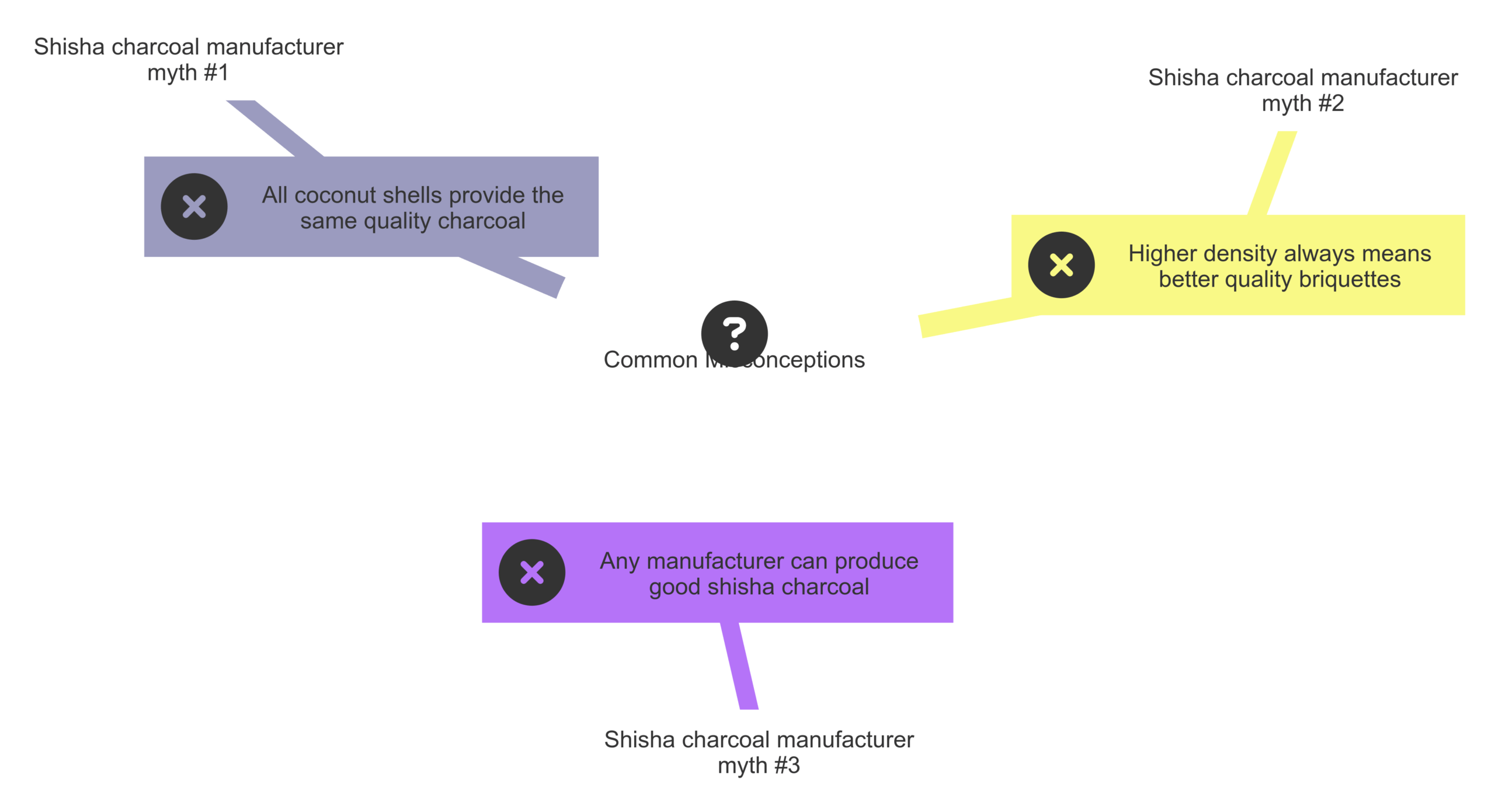
Myths about shisha charcoal manufacturer
- Ocean Freight Shipping & Logistics Price for Shisha Charcoal in November 2025 - November 1, 2025
- New Regulation for Transport Coconut Shell Charcoal Briquettes (Shisha Charcoal) - October 30, 2025
- Protected: Shipping and Delivery of Shisha Charcoal – Coconut Shell Shisha Charcoal Briquettes from Indonesia - October 30, 2025
